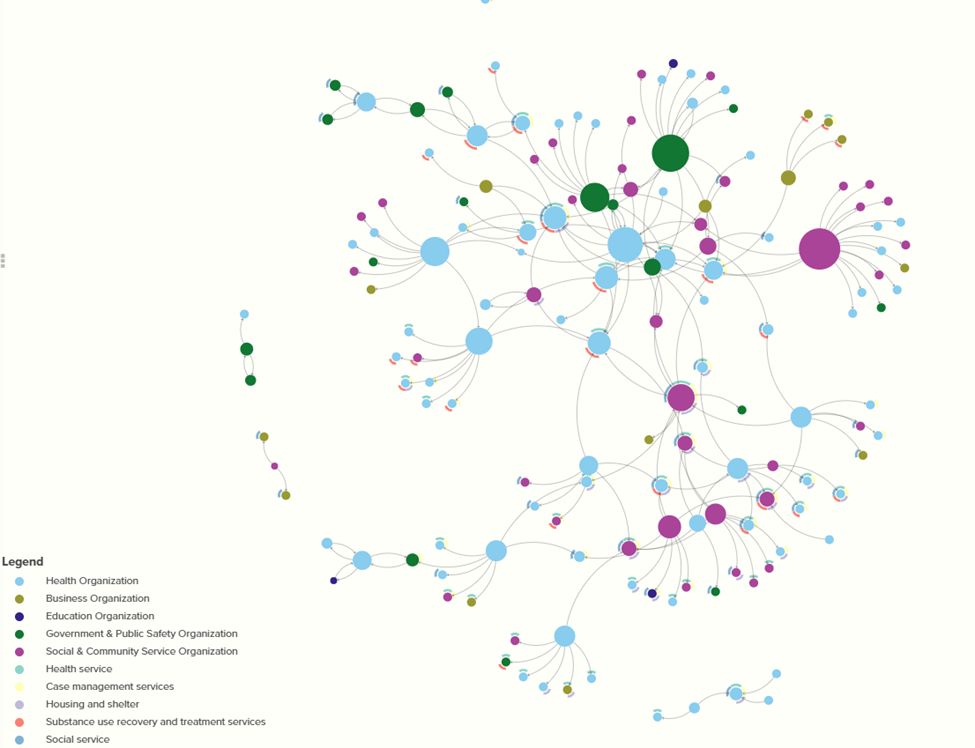Collaborating to Address the Opioid Crisis: Identifying Referral Networks
By The Polis Center at IUPUI
Caring for patients with complex diagnoses requires cooperation among several professionals. When a diagnosis stems from symptoms with socio-behavioral components, cross-sector coordination is often necessary.
Treating patients with substance use disorder involves more than just medical intervention – other organizations in the community are often involved, such as the justice system, social services, ongoing health education, and others. How do these organizations refer patients to other services in order to meet their needs?
Through the IDP, we built a network map that shows how organizations are referring to and from each other. Program administrators can use these network maps to determine which other organizations may help extend their capacity to meet client needs by expanding their referral networks.

Understanding Referrals
Adequately treating patients with a substance use disorder requires more than just knowing that there are services available. Comprehensive care networks are composed of many organizations that offer a variety of services, and that are willing to work collaboratively to meet patient needs.
When looking at referrals in a network map, several organizations emerge as referral hubs, but the way they make and receive referrals varies. For the purposes of this effort, we generally define referrals in two ways:
- The first relates to a formalized process where a professional at one organization, such as a medical doctor, might refer patients to other providers for specific care.
- The second way includes less formal referrals, including suggestions or guidance on where a client can obtain a specific service.
In the referral map, we show a few examples to describe the various types of hubs.
- Indegree Centrality: Organizations that receive a lot of referrals.
Salvation Army Harbor Light offers a wide variety of services and provides, while many of the organizations that refer clients to Harbor provide fewer services. Its variety of services is perhaps why Harbor receives so many referrals.
Valle Vista is another organization that receives many client referrals. However, it offers only one service. Nonetheless, several organizations of various types refer their clients to Valle Vista, indicating that it is a trusted organization in the community.
- Outdegree Centrality: Organizations that make many referrals to other organizations have a high outdegree centrality. Given the extent to which the Indiana Recovery Alliance engages with other organizations, it serves as a major hub for connecting people with the services and information they need.
- Betweenness Centrality: Organizations with high betweenness represent the shortest distance between other major organizations. In other words, a referral to this organization opens a wide network for client services. When this organization needs to give client referrals, they typically have a wide network from which to choose the best services to meet client needs. Eskenazi Health Midtown is a large organization that is part of a much larger health network, which certainly contributes to its high degree of betweenness. Nevertheless, it represents an important link the service continuum for patients with substance use disorder.
Explore the Map
Explore the network map and discover how organizations can use it to build collaborations in address the substance use crisis in Marion County, Indiana.
Program administrators can use these network maps to determine which other organizations may help extend their capacity to meet client needs by expanding their referral networks.
Partnering with organizations with high indegree centrality may improve client services by linking clients with trusted services.
Organizations with high outdegree centrality may improve the broader care continuum by expanding an organization’s extended referral network.
Finally, collaborations with organizations exhibiting a high degree of betweenness are excellent brokers for growing a strong referral network.
